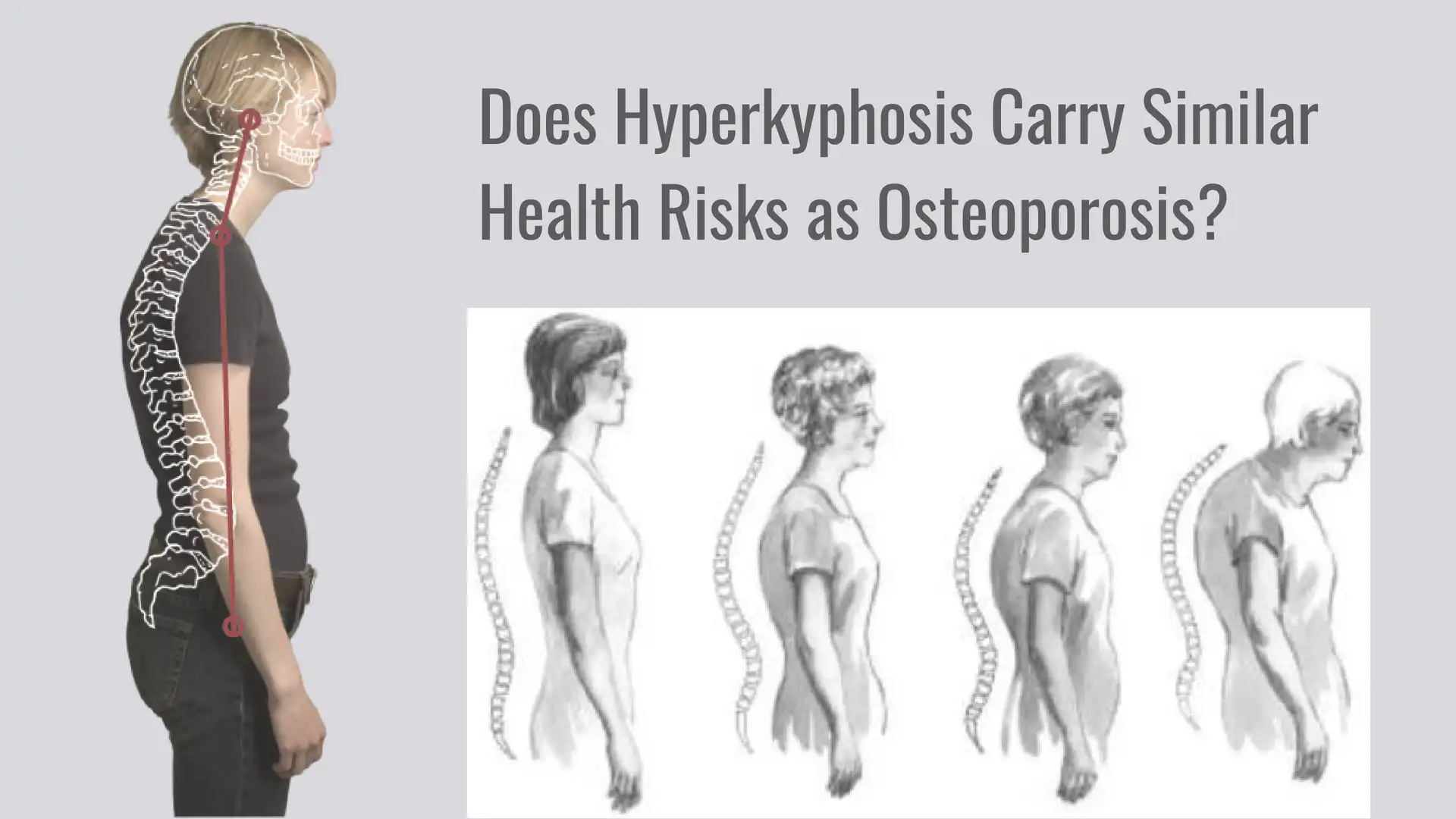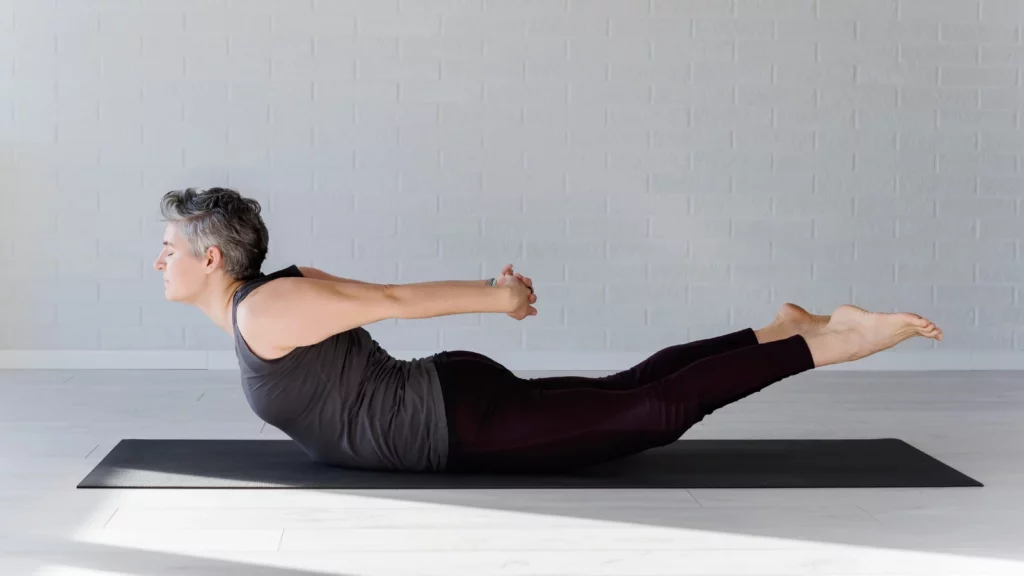Yoga for Posture Improvement: The Health Problem You Never Knew You Had

If you’ve reached your mid-50s or later, go ahead, and measure yourself. Chances are you’ll discover something peculiar. You’ve shrunk. Perhaps just half an inch, perhaps an inch, perhaps even more.
Indeed, if you’re like many people, by the time you reach your 70s, you might have lost 2-3 inches in height.
While shrinking an inch or two in itself is nothing to worry about, the processes that cause the reduction in size are something you should care about.
Two main processes are involved in this loss of height. Firstly, the discs between your vertebrae lose moisture and dry out as you age. Healthy discs act as shock absorbers for the spine and keep the spine flexible. When they dry out, they become less supple and provide less of a cushioning effect. Worse, drier discs change shape and become flatter and thinner, making them more prone to injury and to the kind of degenerative changes that may lead to chronic back pain down the road.
A Plague of the Computer Age: Forward Head Posture and How Yoga Can Help

The other huge factor in the shrinking equation is the age-related deterioration of posture, which begins to set in as early as age 25. At that point, the soft tissues begin to weaken and give in to the relentless pull of gravity.
For most people, the first visible signs of a deteriorating posture are a forward head and an exaggerated upper spine curvature. And here is the bad news: if you don’t do anything about it, you set yourself up for a host of health problems down the road.
Unfortunately, while the forward-leaning head, rounded shoulders, and sunken chest used to be the signature posture of old age, it is quickly becoming almost universal in modern society. The problems these causes are only just beginning to become recognized.
When the head sits in its natural, balanced position atop your neck, its 10 to 12 pounds of weight is balanced effortlessly atop your spine. When the head begins to shift forward, that load increases by a factor of 10 for every inch the head moves forward. If your head moves forward two inches, it increases your neck and muscle load by a whopping 20 pounds!

Since a drooping head and rounded shoulders develop slowly and over time, we don’t feel this extra weight. The body finds ways to compensate for the abnormal leverage on the upper spine. But it compensates in ways that are not that great for your health. The muscles in the neck and upper shoulders tighten up and become stiff and inflexible. The normal curve of the neck begins to flatten as the spine gradually changes its shape to better deal with the excess load. The discs in the neck get compressed and weakened.
Studies have shown that the greater the forward head position, the more likely people are to experience neck or shoulder pain or even chronic tension headaches. The further forward the head is, the worse the pain.
Poor posture affects your health in numerous other ways, however. One group of researchers, led by John Lennon, BM, MM. C., and Norman Shealy, M.D., put it this way in an article in the American Journal of Pain Management:
“[We believe] that posture affects and moderates every physiologic function from breathing to hormonal production. Spinal pain, headache, mood, blood pressure, pulse, and lung capacity are among the functions most easily influenced by posture.
The most significant influences of posture are upon respiration, oxygenation, and sympathetic function. Ultimately, it appears that homeostasis and autonomic regulation are intimately connected with posture. The corollary of these observations is that many symptoms, including pain, may be moderated or eliminated by improved posture.”
Translation? Posture impacts all bodily functions, particularly breathing and, thereby, the oxygen supply to the body’s cells. Posture also affects the sympathetic function of the body and its ability to regulate itself and maintain internal balance.
How Hyperkyphosis Triggers a Cascade of Health Issues
Still, these issues are nothing compared to the problems a hunched-over, drooping posture creates as we grow older. A seriously rounded back is a contributing factor to almost every single age-related issue you don’t want.
In medical terms, as the hunched, forward-rounded posture becomes worse with age, it is referred to as hyperkyphosis. Hyperkyphosis develops when the muscles and other soft tissues can no longer hold up the weight of the head and torso, and the chest and spine gradually cave into the hunched-over posture of old age. Fully developed, it becomes the dreaded dowager’s hump.
Only in recent years have researchers really begun to chart the effects of this posture in older people. What they are discovering is pretty remarkable.
Hyperkyphosis Brings Same Health Risks as Osteoporosis

You’ve heard about how important it is to prevent osteoporosis to avoid fractures as you get older. So here’s the interesting part: a slumped forward posture—if allowed to mature into the hyperkyphosis of old age—puts you at risk for the exact same issues as osteoporosis. And not only that—it is a contributing factor to a host of other health issues as well.
Growing Disability. People with hyperkyphosis are more likely to have difficulty performing simple daily tasks like bathing and washing themselves. They are also more likely to fall and hurt themselves. All of this paves the road to the nursing home.
Growing Risk of Fractures. Hyperkyphosis has also been found to be a risk factor for fractures of the hip, leg, wrist, shoulder, and arm. The risk is greater the more hunched the back is. It is independent of bone mass density, which suggests that hyperkyphotic slumping is a separate risk factor for suffering fractures, on par with osteoporosis.
Restricted Breathing. It doesn’t stop there, however. When a person is constantly stooped forward, it puts tremendous pressure on the chest and lung cavity. This, in turn, restricts breathing capacity or creates shortness of breath. The breath is the source of vital, life-giving oxygen to all the cells of the body. In the elderly, shortness of breath leads to a host of health issues, including increased anxiety and depression, reduced happiness, and, again, reduced ability to undertake normal daily functions.
Some researchers claim that shortness of breath is a main factor of general health deterioration in the elderly. Apart from making a person feel miserable, shortness of breath also undermines the body’s vital functions. The elderly who suffer from moderate to severe shortness of breath are more likely to die from cardiovascular or lung disease.
Earlier Mortality. With all of this going on, it’s not a surprise that people with hyperkyphosis die earlier than their peers. Studies have shown that older men and women with a forward-hunched posture have higher death rates; in one study, they had a 44 percent greater rate of mortality.
So why haven’t you heard about this before? Until recently, hyperkyphosis has been largely ignored because it was assumed that it was caused by osteoporosis. Doctors believed that it resulted from tiny fractures of the vertebrae, which in turn caused the spine to collapse forward into a dowager’s hump.
However, recent research shows that hyperkyphosis often develops without vertebral fractures. In fact, about two-thirds of older people with hyperkyphosis don’t have any fractures of the spine.
Keeping Your Posture Youthful: Yoga for Posture Improvement

If your mama admonished you to stand up straighter, she had a point: Posture affects our health in numerous ways, and maintaining the body’s structural integrity inevitably involves working on keeping a good posture.
If you start out with a good posture, the deterioration of posture won’t be noticeable until around age 45 to 50, when the first signs of aging become apparent. If you already have a slumped-over posture, however, the health of your back will deteriorate even faster once aging undermines your body’s ability to resist the downward pull of gravity.
It takes a while to counteract poor postural habits and restore normal ones. It involves not just strengthening weak muscles and stretching muscles that have grown tight but a fundamental resetting of body awareness and the sense of your body in space. However, retraining postural habits is entirely possible, and generally speaking, the earlier you start, the better.
If you already have an exercise routine, it’s important to add a posture-balancing component to it. Fitness routines like Pilates and yoga that build core strength are a great place to start. Yoga is particularly useful because it trains the spine to keep functioning in all six planes of motion. This, in turn, keeps the discs more lubricated and moist—counteracting the drying out of the discs, which is the other factor in losing height.
Nothing has a greater impact on your posture than your daily habits, so you can get great results from maintaining your posture throughout the day. It takes time and patience to rebuild posture. You have to build new muscle mass to hold you upright and reshape tissues that have frozen into the wrong shape.
Posture is an important dimension of fitness that you can’t afford to ignore. The simple act of straightening up throughout the day can change your life. Literally, as you regain your normal spinal curves and open up your posture, you will begin to feel better all over.
Keeping these simple principles in mind for keeping the spine and back healthy will help you lay a safer foundation for your long-term health. As you develop a youthful posture, balanced back, and flexible spine, you will not just feel better, but your appearance will become increasingly attractive, graceful, and ageless. It’s well worth the time and attention.

Yoga teachers and movement therapists Terry Smith, Ph.D., RYT-200, LMT, and Eva Norlyk Smith, Ph.D., RYT-500, CMT, are co-founders of YogaUOnline.com as well as of the therapeutic yoga program, Healthy Back, Healthy Body, which offers a series, of course, modules focused on improving back health and restoring balance and fluidity to the spine.



